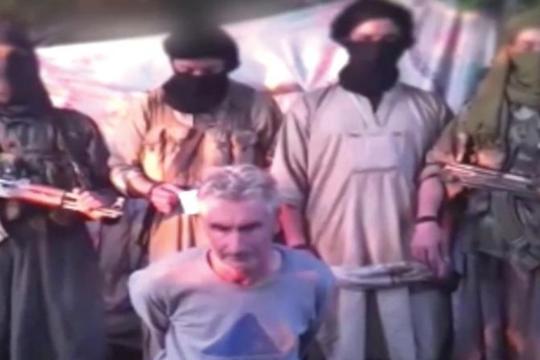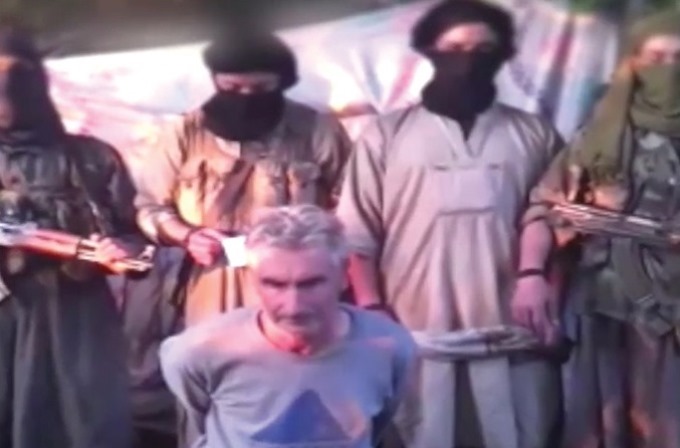
 |
| Members of the group Jund al-Khilafah, or Soldiers of the Caliphate, stand behind French mountaineer Herve Gourdel just before beheading him in this still image from a video published online 24 September 2014 [AP Photo] |
| Abstract Journalist and aid worker beheadings at the hands of the Islamic State (IS) group (also known as Daesh) have reversed the gains made by certain pan-Arab media institutions, especially AlJazeera, in giving a voice to the voiceless. While the Arab region will remain in the headlines, the publicised nature of the beheadings means the story will be told from a different place: the frontlines. Audiences will most likely begin to see the proliferation of embedded journalism in the region, or journalists reporting under the protection of the military. Furthermore, this post-beheading era will see the rise of “newsletter” journalism in which news subjects post their own stories online, leaving no room for journalists to verify the authenticity and validity of sources. This report will explain the impact of the recent journalist beheadings and kidnappings on overall journalism and news coverage in the Arab world, arguing that the biggest loser in this new reality will be the Arab people. |
Introduction
The trend of storming media offices by angry crowds, intimidating and sometimes killing journalists is gaining momentum in some parts of the Arab world. For example, Houthi fighters occupied Suhail Television Channel office in Sanaa and vandalized the buildings after they captured the capital city.(1)
AlJazeera’s Beirut offices were stormed and its staff threatened by a group of Lebanese army supporters.(2) However, biggest scare for journalists in the region has been the gruesome beheadings of James Foley and Steven Sotloff, in addition to other journalists. Their murders have cast uncertainty on the future of objective coverage of the Arab world, reintroducing an environment of fear, something most thought was a thing of the past, particularly with the advent of pan-Arab news organizations. There was a growing feeling at some stage that the region wanted and appreciated free and fair journalism. In general, publics hailed the rise of citizen journalism which covered the Arab world without fear nor favour. Pan Arab media institutions introduced new stories about the Arab world, including human rights stories and a plethora of human success stories. Furthermore, the biggest ongoing story, the plight of the Palestinians, gained an unprecedented balanced narration. For the first time in the history of the occupation, Arab journalists of various backgrounds and languages were covering Palestine. This report will explain the impact of the recent journalist beheadings and kidnappings on overall journalism and news coverage in the Arab world, arguing that the biggest loser in this new reality will be the Arab people.
New reality of journalism in the Arab world
The advancement and rapid adaptation of new forms of media technology have added a positive aspect to journalism in the Arab world. According to the Arab Social Media Report, as of May 2014, sixty-seven per cent of Facebook users were between fifteen and twenty-nine years old.(3) The positive impact of Twitter in the Arab Spring, particularly in Egypt, was widely reported. Although watching television and pictures of any kind are prohibited by some Islamic schools of thought, television and the Internet are thriving in the region. According to a popular Muslim cleric, Muhammed Salih al-Munajjid, host of the islamqa.com (Islam Question and Answer) website, “Television is a dangerous device and its harmful effects are very great, like those of the cinema, or even worse”(4). Al-Munajjid is considered one of the respected scholars of the Salafist movement, an Islamic school of thought whose teachings are said to inspire radical movements in the Arab world, including al-Qaeda and a group called al-Dawla al-Islamiya fil Iraq wal Sham (also known as the Islamic State, IS or Daesh). Notwithstanding those injunctions, al-Qaeda and Daesh are spreading their messages through broadcast on the Internet and television. In fact, they have managed to manipulate the news agenda with their broadcast of beheadings and carefully choreographed messages from their hostages. These groups’ shrewd media capabilities and Internet use have indeed proven to be the greatest network to propagate their messages. They are also utilizing the Internet to recruit fighters from around the world and to disseminate voice and video footage to mainstream news organizations.
There was a time when AlJazeera Media Network was criticised for running the voice recordings and videotapes of Osama Bin Laden. It is interesting to witness that most international media organization are now doing the same, a clear indication that the rules of journalism are certainly changing. The rise and prevalence of Internet-generated footage has introduced a new dimension in journalism because news organizations used to receive most of their footage from journalists on the ground and from the news agencies whose authenticity was unquestionable. However, most of the coverage about various conflicts in the Arab world is now sourced from websites administered by rebel and opposition groups. This means that those in the media who ignore these websites stand to miss important stories because they are proving to be key sources of information. The majority of stories about the Syrian revolution and other parts of the Arab world were sourced from citizen journalists and rebel groups. This new reality on the ground has left most media organizations with few options but to broadcast whatever these sources provide with a disclaimer that “this information cannot be independently verified”.
Ramifications
The blanket acceptance of broadcast materials from rebel and opposition groups allows them to dictate the news media agenda. In some cases, they have created and maintained that role by preventing the media from operating in areas they control, monopolizing the media space. Journalists who dare to venture into their spaces of operation are abducted and eventually killed. The mainstream media now largely rely on the narrative of citizen journalists, rebel groups and freelancers.
There are still journalists who believe that the best way to tell the story is to be on the ground. Consequently, many have opted for embedded journalism despite the fact that this has constrained the field in the past. Previously, the side of the conflict hosting the media tended to only expose journalists to their side of the story. During the Iraq and Afghanistan war, most Western media found it convenient to be embedded with the US-led coalition ground forces. The challenge of embedded media this time around is that this war will not have boots on the ground. The new US-led coalition will fight from the air and only give strategic and military support to their preferred rebel groups on the ground, leaving rebels to control the media space on the ground. There has already been a slant in news reporting, particularly on stories involving Peshmerga and other Kurdish forces in Iraq and Syria.
A second ramification is the rise of frontline reporting of events in the region, often from headquarters outside the Arab world. Consequently, only conflict stories are dominating Arab world-related news, in turn fuelling stereotypes. Stories of human importance, particularly those that cover economic progress and tourism opportunities, have disappeared from the screens. Reporting from the frontlines has always been a great challenge in covering the developing world, including the Arab world. The disadvantage of frontline reporting is that it deprives journalists of experiencing reality on the ground. Stories are often narrated by second-hand sources and reporters never get a chance to validate information.
Before the recent events that involved kidnapping and beheading of journalists, many media organisations sent journalists to cover the region. Furthermore, the rise of Pan-Arab channels and exclusivity in their coverage compelled many television news networks to establish presence in the Arab world. The growing number of bilingual journalists, many from the Arab diaspora, meant that many media institutions had a chance to effectively cover news from the region. However, the killing, abduction and harassment of journalists has led to many institutions pulling out their personnel and closing their operations in the region. This will certainly have negative ramifications. International news organisations will once again rely on local junior staff and freelancers for research and general newsgathering. The absence of professional journalism will lead to compromise of quality and standards, including situations in which drivers are used as translators, soundmen and cameramen.
Conclusion
Pan-Arab news organisation and new Arab services within the established mainstream media fought language barriers and costs of newsgathering to allow for proper reporting. Many news organisations started sending correspondents to report from the field. However, this report has argued that harassment of journalists is going to reverse any gains that have been made. The losers in this new reality will be the people of the Arab world, causing stereotypes that exist about the people of the region to persist. It will take a great deal of effort to reverse those stereotypes in the absence of strong journalism in the Arab world. The Arab world has many stories to share with the world aside from conflict. The recent beheadings and kidnappings mean journalistic coverage of the region will be from the frontlines, indicating that most of the stories are likely to be manipulated, and efforts to give a voice to the voiceless of the Arab world will be reversed in the same way the Arab Spring is being reversed.
__________________________________________________
Thembisa Fakude is a researcher at AlJazeera Centre for Studies.
References
1. Ali Saeed, “RSF: Yemeni Journalists Threatened by Houthis”, Yemen Times, 28 October 2014, http://www.yementimes.com/en/1828/report/4493/RSF-Yemeni-journalists-threatened-by-Houthis.htm
2. SyndiGate.info, “ Lebanese Protesters Storm AlJazeera’s Beirut Office”, Al-Bawaba, 28 September 2014, http://www.albawaba.com/news/al-jazeera-beirut-608279.
3. Dubai School of Government Governance and Innovation Program, “Arab Social Media Report”, Dubai School of Government GIP, 25 June 2014, http://www.arabsocialmediareport.com/home/index.aspx
4. Islamqa.com, “Biography of Shayk Muhammad Saalih al-Munajjid”, Islam Question and Answer, http://islamqa.info/en/shaikh
